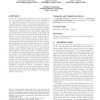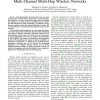21 search results - page 4 / 5 » On the impact of layer-2 on node degree distribution |
IPPS
2000
IEEE
14 years 28 days ago
2000
IEEE
As communication and I/O traffic increase on the interconnection network of high-performance systems, network contention becomes a critical problem drastically reducing performan...
SIGMETRICS
2003
ACM
14 years 1 months ago
2003
ACM
It has been observed that the degrees of the topologies of several communication networks follow heavy tailed statistics. What is the impact of such heavy tailed statistics on the...
INFOCOM
2010
IEEE
13 years 7 months ago
2010
IEEE
—Wireless sensor network (WSN) applications require redundant sensors to guarantee fault tolerance. However, the same degree of redundancy is not necessary for multi-hop communic...
ICC
2009
IEEE
13 years 6 months ago
2009
IEEE
Typically, topology control is perceived as a per-node transmit power control process that achieves certain networklevel objectives. We take an alternative approach of controlling ...
ICDCS
2007
IEEE
14 years 2 months ago
2007
IEEE
In unstructured peer-to-peer (P2P) networks, the overlay topology (or connectivity graph) among peers is a crucial component in addition to the peer/data organization and search. ...


